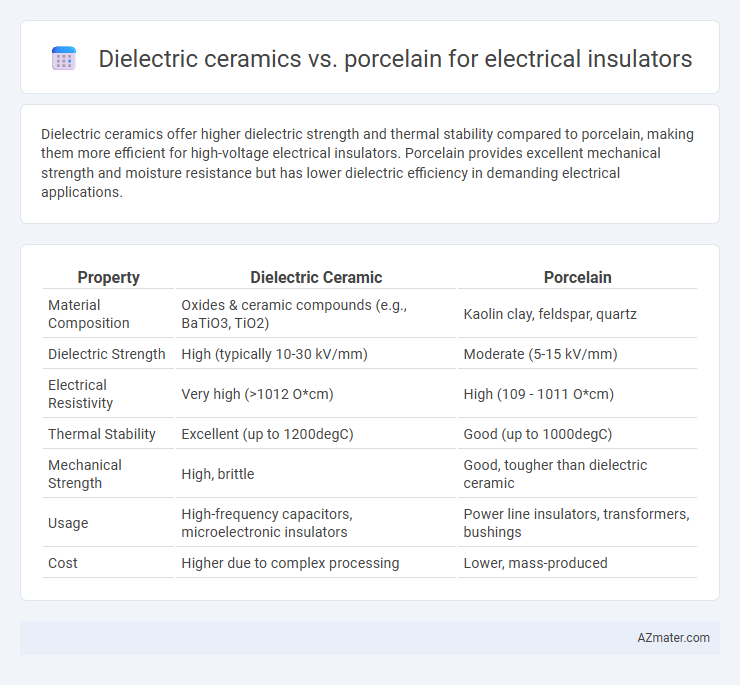Dielectric ceramics offer higher dielectric strength and thermal stability compared to porcelain, making them more efficient for high-voltage electrical insulators. Porcelain provides excellent mechanical strength and moisture resistance but has lower dielectric efficiency in demanding electrical applications.
Table of Comparison
| Property | Dielectric Ceramic | Porcelain |
|---|---|---|
| Material Composition | Oxides & ceramic compounds (e.g., BaTiO3, TiO2) | Kaolin clay, feldspar, quartz |
| Dielectric Strength | High (typically 10-30 kV/mm) | Moderate (5-15 kV/mm) |
| Electrical Resistivity | Very high (>1012 O*cm) | High (109 - 1011 O*cm) |
| Thermal Stability | Excellent (up to 1200degC) | Good (up to 1000degC) |
| Mechanical Strength | High, brittle | Good, tougher than dielectric ceramic |
| Usage | High-frequency capacitors, microelectronic insulators | Power line insulators, transformers, bushings |
| Cost | Higher due to complex processing | Lower, mass-produced |
Introduction to Electrical Insulators
Dielectric ceramics and porcelain are two primary materials used as electrical insulators, characterized by their high resistivity and ability to withstand electrical stress without conducting current. Dielectric ceramics offer superior thermal stability and lower dielectric loss compared to porcelain, making them ideal in high-frequency and high-temperature applications. Porcelain insulators, made from a mixture of clay, feldspar, and quartz, provide mechanical strength and resistance to environmental degradation, widely used in power transmission and distribution systems.
Overview of Dielectric Ceramic Insulators
Dielectric ceramic insulators exhibit excellent electrical resistivity and high dielectric strength, making them ideal for high-voltage applications. Their crystalline structure provides superior mechanical stability and thermal resistance compared to porcelain, enhancing performance under extreme conditions. These insulators are widely used in power transmission and electronic devices due to their low dielectric loss and robustness.
Overview of Porcelain Insulators
Porcelain insulators, made primarily from clay, kaolin, feldspar, and quartz, are widely used in electrical systems due to their excellent insulating properties, mechanical strength, and resistance to weathering and electrical stress. Their dielectric strength typically ranges from 12 to 20 kV/mm, providing reliable insulation in high-voltage applications, especially in substations and transmission lines. Porcelain insulators exhibit low moisture absorption, high durability, and superior resistance to chemical and thermal degradation compared to other materials like dielectric ceramics.
Material Composition and Properties
Dielectric ceramics typically consist of complex oxides such as barium titanate (BaTiO3) and lead zirconate titanate (PZT), offering high dielectric constants and excellent insulating properties under varying electric fields. Porcelain is primarily composed of kaolin, feldspar, and quartz, providing superior mechanical strength, thermal stability, and resistance to environmental degradation. Dielectric ceramics excel in applications requiring high permittivity and low dielectric loss, while porcelain is favored for its durability and robustness in high-voltage insulators.
Electrical Performance Comparison
Dielectric ceramics exhibit higher dielectric strength and lower dielectric loss compared to porcelain, making them more efficient for high-frequency electrical insulators. Porcelain offers excellent mechanical strength and moisture resistance but typically shows higher dielectric constant and lower insulation resistance under humid conditions. The superior electrical performance of dielectric ceramics in terms of insulation resistance and breakdown voltage aligns well with modern high-voltage applications requiring reliable and stable insulation.
Mechanical Strength and Durability
Dielectric ceramics exhibit superior mechanical strength and durability compared to porcelain, making them more resistant to mechanical shocks and thermal stress in electrical insulators. Their higher fracture toughness and enhanced resistance to cracking under load contribute to longer service life in harsh environments. Porcelain, while offering good dielectric properties, generally has lower mechanical strength and is more prone to chipping and degradation over time.
Resistance to Environmental Factors
Dielectric ceramics exhibit superior resistance to environmental factors such as moisture, temperature fluctuations, and chemical exposure compared to porcelain, making them ideal for harsh electrical insulator applications. They maintain stable dielectric properties under extreme conditions, reducing the risk of insulation failure and prolonging service life. Porcelain insulators, while cost-effective, are more susceptible to surface degradation and reduced performance when exposed to severe weather and pollutants.
Installation and Maintenance Considerations
Dielectric ceramics offer superior thermal stability and mechanical strength compared to porcelain, making them easier to install in high-stress electrical environments due to reduced risk of cracking during handling. Porcelain insulators require more careful handling and regular maintenance to prevent surface contamination and moisture ingress, which can degrade their insulating properties over time. Installation efficiency favors dielectric ceramics as they demand less frequent inspections and maintenance, reducing long-term operational costs.
Cost Analysis and Economic Viability
Dielectric ceramic insulators generally have higher initial costs than porcelain insulators due to advanced material properties and manufacturing processes, but offer superior electrical strength and durability, potentially reducing maintenance and replacement expenses over life cycle. Porcelain insulators are more economical upfront, widely available, and easier to produce, making them cost-effective for many standard power distribution applications despite lower mechanical strength and longer-term service challenges. Evaluating economic viability requires balancing initial investment with long-term operational efficiencies and failure rates, where dielectric ceramics may justify higher costs in high-performance or critical-use scenarios.
Application Suitability and Industry Recommendations
Dielectric ceramics exhibit superior electrical insulation properties and high thermal stability, making them ideal for high-frequency and high-voltage applications in telecommunications and power transmission industries. Porcelain, known for its mechanical strength and moisture resistance, is widely recommended in utility substations and overhead line insulators where environmental durability is paramount. Industry standards often favor dielectric ceramics for compact electronic components, whereas porcelain remains the preferred choice for large-scale outdoor electrical insulators due to its robustness and cost-effectiveness.

Infographic: Dielectric ceramic vs Porcelain for Electrical insulator
 azmater.com
azmater.com